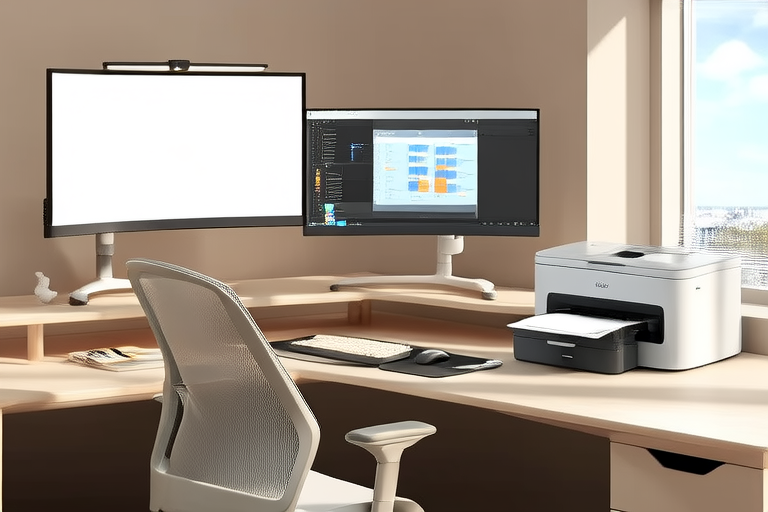Introduction
In today’s fast-paced business environment, efficiency is key to success. Modern office equipment plays a crucial role in streamlining workflows and boosting productivity. From printers and scanners to multifunctional devices and digital assistants, the right tools can make all the difference. This guide will walk you through the essential modern office equipment, helping you choose the best options for your workspace and maximize your efficiency.
Understanding Your Needs
Before diving into specific equipment, it’s important to understand your office’s unique requirements. Different businesses have different needs, so a one-size-fits-all approach won’t work. Consider factors like the size of your team, the nature of your work, and the frequency of tasks.
Assessing Workflow Requirements
Start by analyzing your current workflow. Identify bottlenecks and repetitive tasks that could be automated or streamlined with the right equipment. For example, if your team frequently prints large documents, investing in a high-capacity printer might be beneficial. If scanning is a regular task, consider a scanner with advanced features like OCR (Optical Character Recognition) to convert scanned images into editable text.
Budget Constraints
While high-end equipment can offer significant benefits, it’s important to balance functionality with cost. Determine your budget and prioritize equipment that addresses your most pressing needs. Look for models with good reviews and reliable customer support to ensure long-term value.
Essential Equipment for Every Office
Once you’ve assessed your needs, it’s time to explore the essential equipment that can enhance your office’s efficiency.
Printers and Scanners
Printers and scanners are among the most commonly used office equipment. When choosing a printer, consider the print speed, resolution, and connectivity options. Laser printers are ideal for high-volume printing, while inkjet printers offer better quality for photo printing. For scanners, look for models with automatic document feeders (ADF) and OCR capabilities to save time and reduce errors.
Multifunction Devices
Multifunction devices combine printing, scanning, copying, and sometimes even faxing into one compact unit. These versatile machines are perfect for small offices where space is limited. They also help reduce clutter and simplify maintenance by consolidating multiple functions into a single device.
Digital Assistants
Digital assistants like smart speakers and tablets can significantly enhance productivity by providing hands-free access to information. These devices can be integrated with voice-activated software to control lights, adjust room temperature, and manage calendars. They can also serve as presentation tools, allowing you to display content without leaving your seat.
Advanced Equipment for Specialized Tasks
For businesses with more specialized needs, there are advanced pieces of equipment that can further streamline operations.
Cloud-Based Storage Solutions
Cloud-based storage solutions allow for seamless collaboration and data management. Services like Google Drive, Dropbox, and OneDrive provide secure, accessible storage for documents, spreadsheets, and presentations. They also enable real-time editing and sharing, making it easier for remote teams to collaborate effectively.
Video Conferencing Systems
With the rise of remote work, video conferencing systems have become essential for maintaining communication. High-quality cameras, microphones, and speakers can greatly enhance the clarity and professionalism of virtual meetings. Look for systems that integrate with popular platforms like Zoom, Microsoft Teams, and Slack for a seamless user experience.
Automated Document Management Systems
Automated document management systems (DMS) can help organize and retrieve documents efficiently. These systems use metadata tagging and AI-driven search capabilities to quickly locate files. Implementing a DMS can save time and reduce the risk of misplacing important documents.
Practical Tips for Maximizing Efficiency
To get the most out of your office equipment, follow these practical tips:
Regular Maintenance
Regular maintenance is crucial for keeping your equipment running smoothly. Schedule routine checks and cleanings to prevent malfunctions and extend the lifespan of your devices. Many manufacturers offer maintenance plans that include service calls and replacement parts.
Training and Support
Ensure that your staff is properly trained on how to use new equipment. Provide comprehensive training sessions and user manuals to familiarize employees with the features and functionalities. Additionally, establish a support system for troubleshooting issues and addressing questions.
Energy Efficiency
Consider energy-efficient equipment to reduce operating costs and environmental impact. Look for ENERGY STAR certified devices that consume less power during both active and standby modes. Properly managing power settings can also contribute to energy savings.
Conclusion
In conclusion, selecting the right modern office equipment is vital for maximizing efficiency and productivity. By understanding your specific needs, exploring essential and advanced equipment options, and implementing practical tips, you can create a well-equipped workspace that supports your business goals. Whether you’re upgrading existing equipment or setting up a new office, take the time to carefully evaluate your options and invest in quality tools that will stand the test of time.
Actionable Steps
- Assess your workflow: Identify areas where equipment can improve efficiency.
- Set a budget: Prioritize purchases based on your financial constraints.
- Research thoroughly: Read reviews and compare features before making a purchase.
- Implement maintenance plans: Ensure your equipment remains in top condition.
- Train your team: Equip your staff with the knowledge to use new technology effectively.
By following these steps, you’ll be well on your way to creating an efficient and productive office environment.
